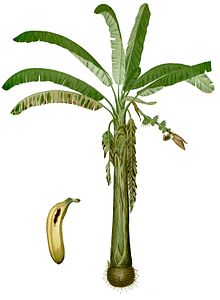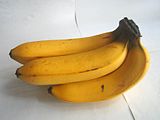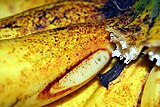Lakatan bananas, also spelled Lacatan, are diploid banana cultivars from the Philippines. It is one of the most common banana cultivars in the Philippines, along with the Latundan and Saba bananas.[1]
| Musa acuminata 'Lakatan' | |
|---|---|
 Lakatan illustration in the 1880 book Flora de Filipinas by Francisco Manuel Blanco | |
| Species | Musa acuminata |
| Cultivar group | AA Group |
| Cultivar | 'Lakatan' |
| Origin | Philippines, Malaysia, Indonesia, Thailand |
Lakatan bananas should not be confused with the Cavendish banana Masak Hijau, which is also known as "Lacatan" in Latin America and the West Indies.
Taxonomy and nomenclature
editThe Lakatan banana is a diploid (AA) cultivar.[2] According to Promusa, it is a triploid (AAA) [3]
Its official designation is Musa acuminata (AA Group) 'Lakatan'.
Synonyms include:
- Musa x paradisiaca L. ssp. sapientum (L.) Kuntze var. lacatan Blanco
- Musa acuminata Colla (Cavendish Group) cv. 'Lacatan'
The Cavendish cultivar Masak Hijau is also called "Lacatan" in Latin America and the West Indies, and is known as "Bungulan" in the Philippines. To avoid confusion, the Philippine Lakatan is usually spelled with a 'k' in botanical literature, while Masak Hijau is usually spelled with a 'c' (Lacatan)[4] or called "Jamaican Lacatan".[2] Other common names for the cultivar in Southeast Asia include "Pisang Berangan" in Malaysia; "Pisang Barangan Kuning" and "Pisang Barangan Merah" in Indonesia; "Kluai Hom Maew" and "Kluai Nga Phaya" in Thailand.[5]
Description
editLakatan typically grows to a height of five to nine feet. The fruits can be harvested 8 to 12 months after planting. Lakatan is susceptible to the Banana Bunchy Top virus.
Lakatan fruits are longer and thicker-skinned than the Latundan bananas and turn a characteristic yellow-orange when ripe.[6]
Uses
editLakatan is the most popular dessert banana in the Philippines. It is more expensive than the more common Latundan and Cavendish bananas. Latundan and Lakatan bananas are both preferred by Filipinos over Cavendish.
They have higher β-Carotene content than other banana cultivars.[7]
Diseases
editSee also
editReferences
edit- ^ Hautea, D.M., G.C. Molina, C.H. Balatero, N.B. Coronado, E.B. Perez, M.T.H. Alvarez, A.O. Canama, R.H. Akuba, R.B. Quilloy, R.B. Frankie, C.S. Caspillo (2002-07-19). "Analysis of induced mutants of Philippine bananas with molecular markers". Institute of Plant Breeding, College of Agriculture, University of the Philippines Los Baños, FAO Corporate Document Repository. Retrieved 12 January 2011.
{{cite web}}: CS1 maint: multiple names: authors list (link) - ^ a b Michel H. Porcher; Prof. Snow Barlow (2002-07-19). "Sorting Musa names". The University of Melbourne. Retrieved 11 January 2011.
- ^ "Lakatan".
- ^ Valmayor, R.V., Espino, R.R.C. and Pascua, O.C. (2002). The Wild and Cultivated Bananas of the Philippines. Los Banos, Laguna, Philippines: PARRFI. p. 242.
{{cite book}}: CS1 maint: multiple names: authors list (link) - ^ Molina, A.B.; Roa, V.N. (2000). Advancing Banana and Plantain R and D in Asia and the Pacific. International Plant Genetic Resources Institute. p. 3. ISBN 978-971-91751-3-1. Retrieved 2021-12-08.
- ^ "BANANA" (PDF). Philippine Department of Agriculture. 2010. Retrieved 20 September 2017.
- ^ Lois Englberger; Ian Darnton-Hill; Terry Coyne; Maureen H. Fitzgerald; Geoffrey C. Marks (2003). "Carotenoid-rich bananas: A potential food source for alleviating vitamin A deficiency" (PDF). Food and Nutrition Bulletin, vol. 24, no. 4. The United Nations University. Archived from the original (PDF) on 26 July 2011. Retrieved 13 January 2011.


